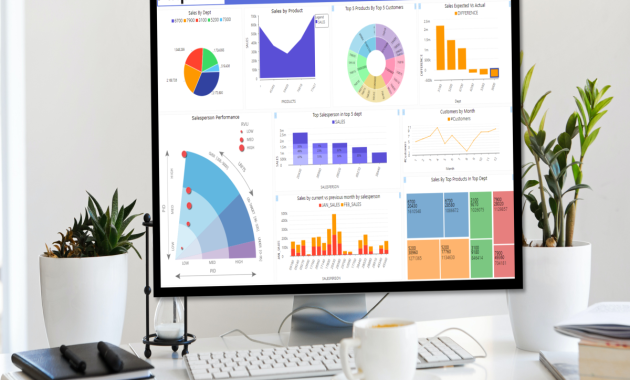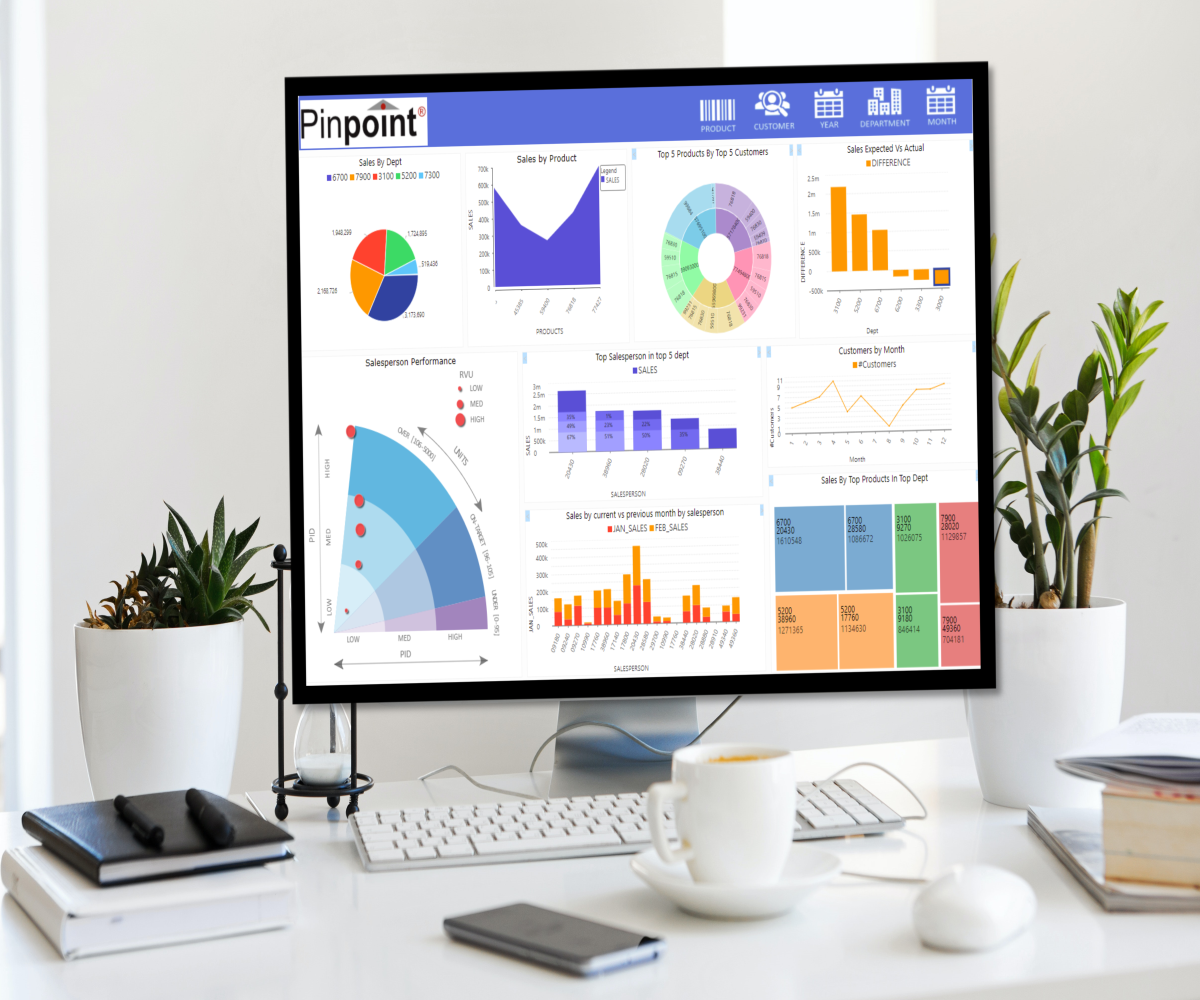
Unlocking Insights: The Power of Self-Service Business Intelligence Software with Advanced Visuals
In the ever-evolving landscape of data-driven decision-making, businesses are constantly seeking ways to gain a competitive edge. One of the most effective tools for achieving this is self-service business intelligence (BI) software with advanced visuals. This powerful technology empowers users to explore data independently, uncover hidden trends, and make informed decisions without relying heavily on IT specialists or data scientists. This article delves into the capabilities, benefits, and considerations of implementing self-service business intelligence software with advanced visuals, offering a comprehensive guide for businesses of all sizes.
The Rise of Self-Service BI
The traditional approach to BI often involved a centralized team of experts who would extract, transform, and load (ETL) data, build reports, and then distribute them to end-users. This process was time-consuming, expensive, and often created a bottleneck for accessing critical information. Self-service business intelligence software, however, has revolutionized this paradigm. It puts the power of data analysis directly into the hands of business users, enabling them to create their own reports, dashboards, and visualizations. This shift has several significant advantages.
- Increased Agility: Users can quickly access and analyze data, allowing them to respond rapidly to market changes and opportunities.
- Improved Decision-Making: With readily available insights, users can make more data-driven decisions, leading to better outcomes.
- Reduced Reliance on IT: Business users can perform their own analysis, freeing up IT resources for more strategic initiatives.
- Enhanced Data Literacy: Self-service BI tools often come with built-in tutorials and training, improving overall data literacy within an organization.
Key Features of Self-Service BI Software
Effective self-service business intelligence software offers a range of features that empower users to explore and understand their data. These features are designed to be user-friendly, intuitive, and accessible to individuals with varying levels of technical expertise.
Data Connectivity
A crucial aspect of any BI tool is its ability to connect to various data sources. Modern self-service BI software supports a wide array of data connectors, including databases (SQL Server, Oracle, MySQL), cloud services (Salesforce, Google Analytics, Amazon Web Services), spreadsheets, and flat files. This allows users to integrate data from multiple sources into a unified view, providing a comprehensive understanding of their business.
Data Preparation and Modeling
Before data can be visualized and analyzed, it often needs to be cleaned, transformed, and modeled. Self-service BI software typically includes features for data preparation, such as:
- Data Cleaning: Removing errors, inconsistencies, and missing values.
- Data Transformation: Converting data into a usable format.
- Data Modeling: Creating relationships between different data sets.
These features empower users to prepare their data effectively, ensuring the accuracy and reliability of their insights.
Advanced Visualizations
The ability to create compelling and informative visuals is a defining characteristic of self-service business intelligence software. These tools offer a wide range of visualization options, including:
- Charts: Bar charts, line charts, pie charts, and other chart types for displaying data trends and comparisons.
- Dashboards: Interactive dashboards that combine multiple visualizations into a single, easy-to-understand interface.
- Maps: Geographic visualizations for analyzing data by location.
- Advanced Analytics: Features like heatmaps, scatter plots, and advanced statistical analysis for deeper insights.
The best self-service BI software allows users to customize visualizations to meet their specific needs and effectively communicate their findings.
Interactive Dashboards and Reporting
Interactive dashboards are a key feature of self-service BI software. They allow users to explore data in real-time, filter and drill down into details, and quickly identify key trends and patterns. Reporting capabilities enable users to generate customized reports that can be shared with colleagues or stakeholders. These reports can be automated and scheduled for regular delivery, ensuring that everyone has access to the latest insights.
Benefits of Using Self-Service BI with Advanced Visuals
Implementing self-service business intelligence software with advanced visuals can provide numerous benefits for businesses. These benefits can lead to significant improvements in efficiency, decision-making, and overall performance.
- Faster Time to Insights: Users can quickly access and analyze data, reducing the time it takes to identify key trends and patterns.
- Improved Data-Driven Decisions: With readily available insights, businesses can make more informed decisions, leading to better outcomes.
- Enhanced Collaboration: Interactive dashboards and reports facilitate collaboration among different teams and departments.
- Increased Productivity: By empowering users to analyze data themselves, businesses can free up IT resources and improve overall productivity.
- Cost Savings: Self-service BI can reduce the need for expensive external consultants and data analysis services.
Choosing the Right Self-Service BI Software
Selecting the right self-service BI software is crucial for maximizing its benefits. Consider the following factors when making your decision:
- Ease of Use: The software should be intuitive and easy to learn, with a user-friendly interface and drag-and-drop functionality.
- Data Connectivity: Ensure the software supports all the data sources you need to connect to.
- Visualization Capabilities: The software should offer a wide range of advanced visualization options to meet your specific needs.
- Data Preparation Features: Look for tools that allow you to clean, transform, and model your data effectively.
- Scalability: The software should be able to handle your current data volume and scale as your business grows.
- Security: Ensure the software has robust security features to protect your sensitive data.
- Pricing: Consider the pricing model and ensure it aligns with your budget and needs.
- Training and Support: Look for software that provides adequate training and support resources.
Implementation Best Practices
Successfully implementing self-service business intelligence software requires careful planning and execution. Consider these best practices:
- Define Your Goals: Clearly define your business goals and how you plan to use the software to achieve them.
- Assess Your Data: Understand your data sources, quality, and structure.
- Choose the Right Software: Select software that aligns with your needs and budget.
- Provide Training: Offer comprehensive training to all users.
- Establish Governance: Implement data governance policies to ensure data accuracy and consistency.
- Promote Adoption: Encourage users to utilize the software and share their findings.
- Monitor and Evaluate: Regularly monitor the software’s performance and evaluate its effectiveness.
The Future of Business Intelligence
The future of business intelligence is firmly rooted in self-service BI software with advanced visuals. As data volumes continue to grow, the need for accessible and intuitive tools will only increase. Innovations in artificial intelligence (AI) and machine learning (ML) are also playing a significant role, with features like automated insights, predictive analytics, and natural language processing (NLP) becoming increasingly common. The trend is towards more user-friendly, intelligent, and powerful BI solutions that empower businesses to unlock the full potential of their data.
Conclusion
Self-service business intelligence software with advanced visuals is a powerful tool that can transform the way businesses operate. By empowering users to explore data independently, uncover hidden trends, and make informed decisions, this technology can drive significant improvements in efficiency, decision-making, and overall performance. By carefully considering the factors outlined in this article and following best practices for implementation, businesses can successfully leverage the power of self-service BI software to gain a competitive edge in today’s data-driven world. Embracing this technology allows companies to transform raw data into actionable insights. The correct implementation of self-service BI software will greatly benefit businesses.
Self-service business intelligence software is an essential tool.
[See also: Related Article Titles]

